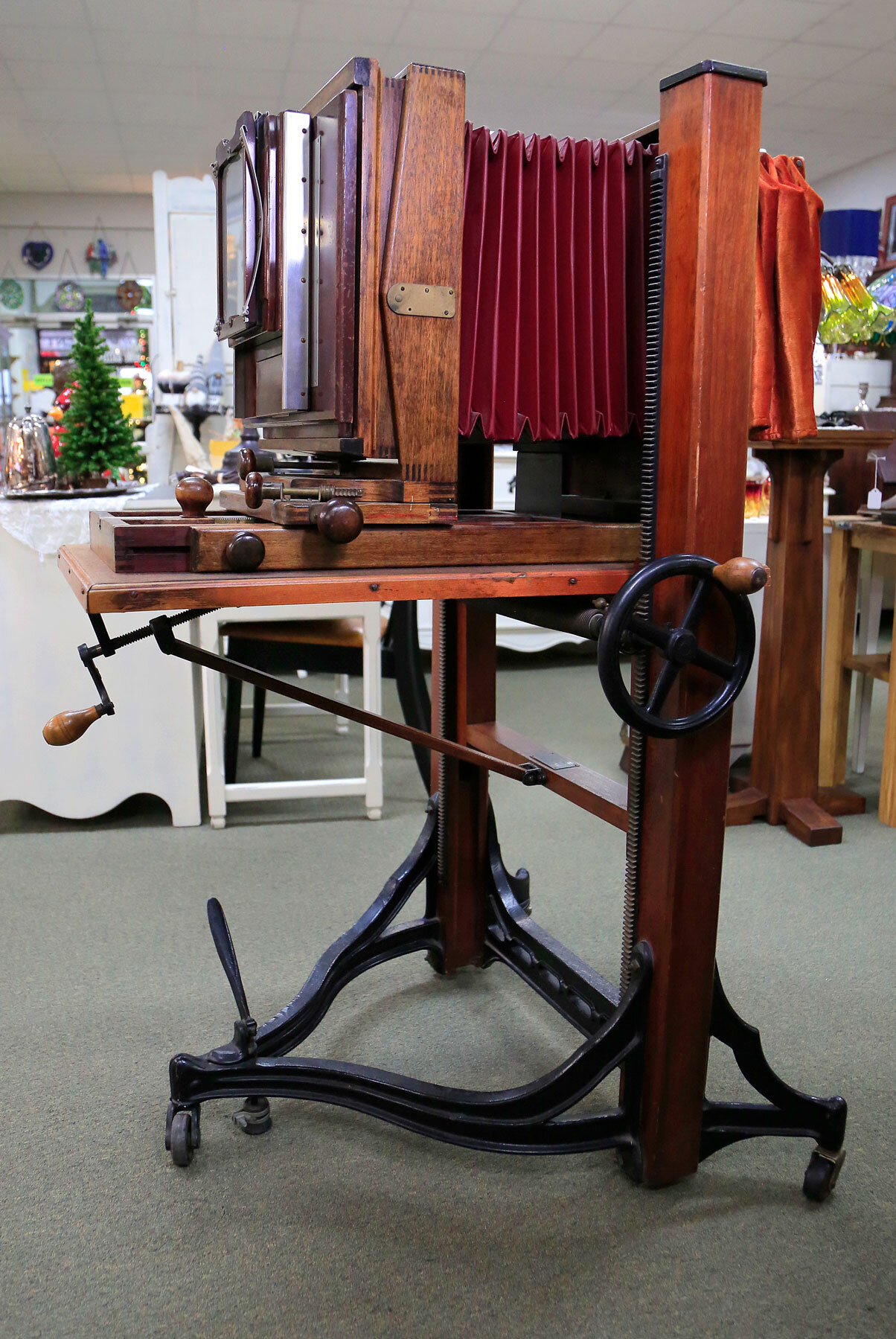Find this unique antique at Past and Present Home Gallery
This specialty large format antique studio camera is a classic showstopper, perfect for a collector looking for that dramatic centerpiece to their collection.
Like any relic from the past, this piece of photographic history represents the technological advancement of its day. It has a rich and complicated story that captures a moment in time which changed how we take pictures today. With a series of varying names to identify the different parts making up this contraption, each element is just another piece to the puzzle of an art form nearly two centuries old.
While this device does not originate back in 1826 when the first photograph was taken, its story begins in New York at a company now known for making eye health products. It was there that two men invented a shutter that would revolutionize the way pictures were taken.
A Shutter with a Story
Rochester, New York, 1910. Rudolph Klein and Theodor Brueck, both shutter designers for Bausch + Lomb, created a mechanism that allowed shutters to work independently from temperature and other atmospheric conditions. It was the first time such a system had been implemented.
After their discovery, both Klein and Brueck left Bausch + Lomb to start a business of their own; one they called “XL Manufacturing Company.” Unfortunately, when they learned that another line of shutters were being developed to be named “X excel L“, the pair decided to re-name their young company “Ilex” to avoid confusion. Thus, in 1911, the Ilex Optical Company was born.
Cameras like this are rare, similar ones found in private collections and museums around the world like at the Camera Heritage Museum in Staunton, Virginia www.cameraheritagemuseum.com. While conditions of such pieces range; the camera here at Past & Present Home Gallery has a label that is easily readable and intact. Just underneath the shutter, the plaque states:
Manufactured by
ILEX OPTICAL CO.
PAT. NO. 1,510,597
Upon further research of the patent number, we found that it originates back to 1922 when first filed; 1924 when the copyright was finally published. This dates the top half of the model to over 90 years old. The original concept was created by none other than Rudolph Klein—one of the two men who began the Ilex company long ago.
The original diagrams for Rudolph Klein’s shutter design patent
A popular brand at the time, it was their invention of a self-contained internal flash mechanism developed during World War II which put Ilex on the map. This new design was so significant that it has been incorporated by manufacturers ever since. Purchased in 1963 by a company now known as Navitar, both Rudolph Klein and Theodor Brueck would be proud to know that their company continues to produce cameras today.
Behind the Base
The label ‘10A’ can be compared to devices of today, i.e. iPhone12, Samsung Galaxy S5, etc. It explains the size (8x10) with a corresponding letter to clarify the update. The 10A Camera was the final design of this particular series—introduced in 1925.
While the top half of the camera identifies as one company, the bottom adds another layer to this relic’s complicated past. Bearing what appears to be two additional names, the inscription reads:
No. 10A
CENTURY STUDIO CAMERA
Made in U.S.A. by
FOLMER GRAFLEX CORPORATION
Starting with ‘Century Studio,’ the Century Camera Company began in 1900 with three former employees of a rival business. In 1903, their stock was bought by none other than George Eastman, the founder of the popular Kodak brand. Once successfully absorbed by its new owner, it then merged with another company to become Folmer Graflex; the name ‘Century’ continuing its usage through the year 1920. Today, Kodak may be a household name—their founder having a museum dedicated in his honor in Rochester, NY—but what became of this now-dissolved Folmer Graflex and how did they fit into this complicated web of photographic history?
To answer this question, we have to go all the way back to the late 1800s with two men named William F. Folmer and William E. Schwing and their New York-based bicycle company. With the popular association between bicycles and cameras surging from the first film taken in 1895, they opted to add cameras to their line of products. Folmer, an inventor, went on to build the first Graflex camera. The accordion-style camera soon became popular for sports and press photography due to its use of a focal plane shutter that was proven to be reliable. This style continued being manufactured for well over sixty years.
However, like the Century Camera Company, in April of 1905 Folmer Graflex was purchased by George Eastman and brought to Rochester, NY. By 1907, the company had transitioned to the ‘Folmer and Schwing Division’ of the Eastman Kodak Company.
A Commonality Among Cameras
When the photography industry first boomed around the 1900’s, there was nothing but options to choose from. Picking bits from a variety of companies allowed consumers the freedom to customize their dream cameras, much like we do with our devices today. For the collector looking to add character and color to their cacophony of cameras or other vintage items, this unique piece holds more than a look through the lens of time. With this haunting addition, fans of photography and ingenuity can see the shadows of a storied past that is still influenced from the great minds that birthed it centuries ago.
It is this common thread of innovation that laces the history of humankind together. This camera, like many of the pieces at Past & Present Home Gallery, tells the story of those before us. By listening to these stories of the past, we see just how wonderful our present is and how bright—just like the flash of a camera—the future can truly be.
If you’re interested in this camera and want to see it in-person or discuss it further, feel free to stop in or contact us. We look forward to talking with you!









